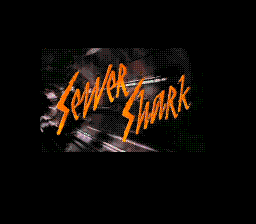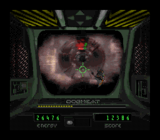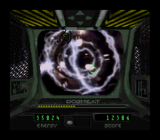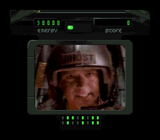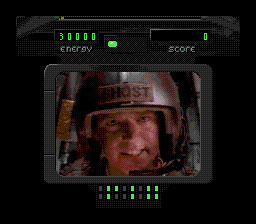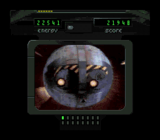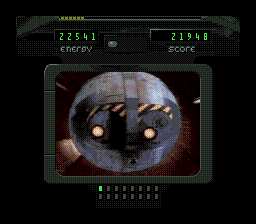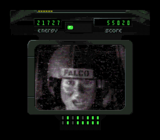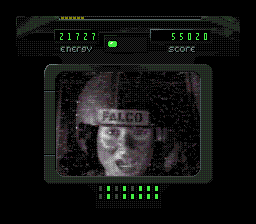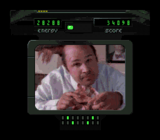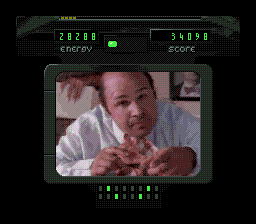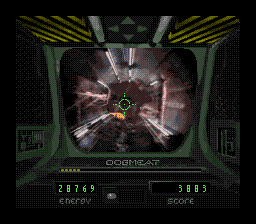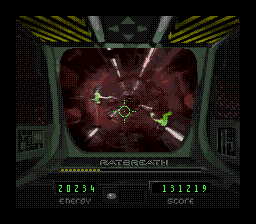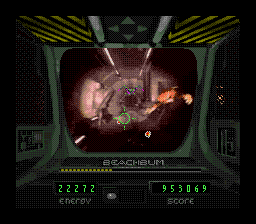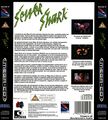Difference between revisions of "Sewer Shark"
From Sega Retro
(expanded) |
|||
| Line 29: | Line 29: | ||
| otherformats={{NonSega|3DO}} | | otherformats={{NonSega|3DO}} | ||
}} | }} | ||
| − | + | '''''{{PAGENAME}}''''' is a [[Sega Mega-CD]] shooting game. It relies heavily on [[full-motion video]]. | |
The game was a launch title in North America, and later on in the console's lifespan ''Sewer Shark'' was distributed as a pack-in game with the Mega-CD console in certain regions. | The game was a launch title in North America, and later on in the console's lifespan ''Sewer Shark'' was distributed as a pack-in game with the Mega-CD console in certain regions. | ||
| + | |||
| + | ==Story== | ||
| + | The game takes place in a post-apocalyptic future where environmental destruction has forced most of humanity to live underground. The player takes on the role of a rookie pilot in a band of "sewer jockeys," whose job is to exterminate dangerous mutated creatures to keep a vast network of sewers clean for "Solar City," an island paradise from which the malicious Commissioner Stenchler gives his orders and critiques. | ||
| + | |||
| + | The player's "Back Seat" (copilot), Ghost, evaluates the player's performance throughout the game, while a small robot named Catfish scouts ahead and gives directions. The player is later assisted by Falco, a female jockey who believes that there is a hidden route to the surface. | ||
==Gameplay== | ==Gameplay== | ||
| − | + | {{ScreenThumb2|Sewer Shark, Recharge Station 1.png|Sewer Shark, Recharge Station 2.png|width=200|Recharge station}} | |
| + | The game is a rail shooter that uses [[full-motion video]] narrative sequences and gameplay backdrops. The player pilots a customised "sewer shark" vehicle named the Hole Hawg through a series of sewer tunnels (called "tubes"). The player is tasked with cleaning up the large sewer network by shooting various creatures. Despite being labeled as the "sewer jockey" (pilot), the ship mostly flies itself, leaving the player to shoot "ratigators" (mutant crosses between rats and alligators), bats, mechanical moles, and other sewer denizens. The player aims the targeting reticle with the D-pad and fires the ship's "Gatling gun" with {{A}} (which can be held for continuous fire). | ||
| + | |||
| + | Along the way, Catfish gives the player directions by announcing the next three tube jumps using clockface directions (twelve for up, three for right, six for down, and niner for left). The tube jump indicator at the top of the screen indicates when the player is approaching an intersection by flashing an arrow green. The player can commit to turning in that direction by pressing {{B}} and then the direction of the jump. The arrow yellow to confirm the turn, and the Hole Hawg automatically makes the jump when the tube approaches. If the player takes a wrong turn or misses a turn, the Hole Hawg eventually hits a dead end and crashes, ending the game. Wrong turns and missed turns are indicated by the arrow flashing red in the tube jump indicator. Directions are randomized and must be taken in order. Later in the game, Catfish is replaced by the "crazy-looking thing," which the player must visually chase through the sewers. | ||
| + | |||
| + | The Hole Hawg cannot be damaged, but it has a limited amount of energy, which depletes slowly during flight and while firing. This energy can be partially replenished at recharge stations. Ghost announces when a recharge station is approaching, and they are also indicated by two lights on the ceiling of the tube. The lights correspond to the entrances to the station: one light is green (representing the open entrance) and the other light is red (representing the closed entrance). The player must jump into the open entrance to recharge the Hole Hawg. If the ship runs out of energy, it crashes and the game ends. | ||
| + | |||
| + | Enemies are a mixture of creatures baked into the full motion video and sprites overlaid on the screen. Shooting down creatures contributes to the player's score (depending on the "weight" of the creature). At certain times, Ghost or Stenchler interrupt the player to give direct feedback. If the player is doing well, they are allowed to continue and are occasionally given a promotion in the form of a new call sign (progressing from Dogmeat to Ratbreath, Exterminator, and finally Beachbum, each accompanied with a change of music). Poor performance eventually causes the game to end. | ||
| − | + | When the player progresses deeper into the sewers, the ship encounters pockets of hydrogen must be detonated to pass through safely. The HUD has a hydrogen gauge underneath the player's callsign that indicates the hydrogen level; when it turns red, Catfish can fire a flare to detonate the hydrogen with {{C}}. | |
| − | The | + | The game features numerous short full-motion video cutscenes that break up the action and progress the plot. All in-game music is generated by the [[Sega Mega Drive]]'s audio chips, as opposed to higher quality Red Book audio. |
| − | + | ===Characters=== | |
| + | {{gallery|widths=200|screens=yes| | ||
| + | {{gitem|Sewer Shark, Characters, Ghost.png|Ghost}} | ||
| + | {{gitem|Sewer Shark, Characters, Catfish.png|Catfish}} | ||
| + | {{gitem|Sewer Shark, Characters, Falco.png|Falco}} | ||
| + | {{gitem|Sewer Shark, Characters, Commissioner Stenchler.png|Commissioner Stenchler}} | ||
| + | }} | ||
| − | + | ===Callsigns=== | |
| + | {{InfoTable|imagewidths=320| | ||
| + | {{InfoRow | ||
| + | | title=Dogmeat | ||
| + | | screenshot=Sewer Shark, Ranks, Dogmeat.png | ||
| + | | desc=Enemies consist of ratigators and bats. | ||
| + | }} | ||
| + | {{InfoRow | ||
| + | | title=Ratbreath | ||
| + | | screenshot=Sewer Shark, Ranks, Ratbreath.png | ||
| + | | desc=Scorpions are added as enemies, which rob the ship of energy if the player fails to shoot them down. | ||
| + | }} | ||
| + | {{InfoRow | ||
| + | | title=Exterminator | ||
| + | | screenshot=Sewer Shark, Ranks, Exterminator.png | ||
| + | | desc=The player now chases the "crazy-looking thing" through the sewers rather than receiving directions from Catfish. Mechanical moles are added as enemies, which explode the ship and end the game if not shot down. | ||
| + | }} | ||
| + | {{InfoRow | ||
| + | | title=Beachbum | ||
| + | | screenshot=Sewer Shark, Ranks, Beachbum.png | ||
| + | | desc=Zerks are added as enemies, which are small fireflies that fly at the Hole Hawg and sap its energy on collision. | ||
| + | }} | ||
| + | }} | ||
==History== | ==History== | ||
===Development=== | ===Development=== | ||
| − | As with ''[[Night Trap]]'', ''Sewer Shark'' was originally intended for release on Hasbro's cancelled Control-Vision (codenamed NEMO) console | + | As with ''[[Night Trap]]'', ''Sewer Shark'' was originally intended for release on Hasbro's cancelled Control-Vision (codenamed NEMO) console, a system that used VHS cassettes as opposed to ROM cartridges. [[Digital Pictures]] subsequently picked up the rights to bring the project to the Mega-CD. |
On the Control-Vision, ''Sewer Shark'', like ''Night Trap'' used four separate video streams which are read simultaneously, allowing for the game to react without the need noticeable loading of data. To achieve this on the Mega-CD, all of the footage was compressed using a bespoke video codec, meaning most of the game is viewed with a border. ''Night Trap'' uses similar technology, as does the later produced ''[[Prize Fighter]]''. | On the Control-Vision, ''Sewer Shark'', like ''Night Trap'' used four separate video streams which are read simultaneously, allowing for the game to react without the need noticeable loading of data. To achieve this on the Mega-CD, all of the footage was compressed using a bespoke video codec, meaning most of the game is viewed with a border. ''Night Trap'' uses similar technology, as does the later produced ''[[Prize Fighter]]''. | ||
| Line 54: | Line 94: | ||
===Legacy=== | ===Legacy=== | ||
| − | Following its Mega-CD launch, Digital Pictures ported the game to the 3DO platform for release in 1994. While gameplay remains largely unchanged, the 3DO version renders at a higher resolution in more colours, bringing the footage closer to the intended VHS quality. | + | Following its Mega-CD launch, Digital Pictures ported the game to the [[3DO]] platform for release in 1994. While gameplay remains largely unchanged, the 3DO version renders at a higher resolution in more colours, bringing the footage closer to the intended VHS quality. |
==Production credits== | ==Production credits== | ||
| Line 134: | Line 174: | ||
:'''© 1992 [[Digital Pictures|Digital Pictures, Inc.]] All Rights Reserved.''' | :'''© 1992 [[Digital Pictures|Digital Pictures, Inc.]] All Rights Reserved.''' | ||
| source=In-game credits | | source=In-game credits | ||
| + | | pdf=Sewer Shark MCD credits.pdf | ||
| console=MCD | | console=MCD | ||
}} | }} | ||
Revision as of 12:30, 22 July 2022
| Sewer Shark | ||||||||||||||||||||||||||||||||||||||||
|---|---|---|---|---|---|---|---|---|---|---|---|---|---|---|---|---|---|---|---|---|---|---|---|---|---|---|---|---|---|---|---|---|---|---|---|---|---|---|---|---|
| System(s): Sega Mega-CD | ||||||||||||||||||||||||||||||||||||||||
| Publisher: Sony Imagesoft | ||||||||||||||||||||||||||||||||||||||||
| Developer: Digital Pictures | ||||||||||||||||||||||||||||||||||||||||
| Genre: Shoot-'em-Up | ||||||||||||||||||||||||||||||||||||||||
| Number of players: 1 | ||||||||||||||||||||||||||||||||||||||||
| ||||||||||||||||||||||||||||||||||||||||
|
Sewer Shark is a Sega Mega-CD shooting game. It relies heavily on full-motion video.
The game was a launch title in North America, and later on in the console's lifespan Sewer Shark was distributed as a pack-in game with the Mega-CD console in certain regions.
Contents
Story
The game takes place in a post-apocalyptic future where environmental destruction has forced most of humanity to live underground. The player takes on the role of a rookie pilot in a band of "sewer jockeys," whose job is to exterminate dangerous mutated creatures to keep a vast network of sewers clean for "Solar City," an island paradise from which the malicious Commissioner Stenchler gives his orders and critiques.
The player's "Back Seat" (copilot), Ghost, evaluates the player's performance throughout the game, while a small robot named Catfish scouts ahead and gives directions. The player is later assisted by Falco, a female jockey who believes that there is a hidden route to the surface.
Gameplay
The game is a rail shooter that uses full-motion video narrative sequences and gameplay backdrops. The player pilots a customised "sewer shark" vehicle named the Hole Hawg through a series of sewer tunnels (called "tubes"). The player is tasked with cleaning up the large sewer network by shooting various creatures. Despite being labeled as the "sewer jockey" (pilot), the ship mostly flies itself, leaving the player to shoot "ratigators" (mutant crosses between rats and alligators), bats, mechanical moles, and other sewer denizens. The player aims the targeting reticle with the D-pad and fires the ship's "Gatling gun" with ![]() (which can be held for continuous fire).
(which can be held for continuous fire).
Along the way, Catfish gives the player directions by announcing the next three tube jumps using clockface directions (twelve for up, three for right, six for down, and niner for left). The tube jump indicator at the top of the screen indicates when the player is approaching an intersection by flashing an arrow green. The player can commit to turning in that direction by pressing ![]() and then the direction of the jump. The arrow yellow to confirm the turn, and the Hole Hawg automatically makes the jump when the tube approaches. If the player takes a wrong turn or misses a turn, the Hole Hawg eventually hits a dead end and crashes, ending the game. Wrong turns and missed turns are indicated by the arrow flashing red in the tube jump indicator. Directions are randomized and must be taken in order. Later in the game, Catfish is replaced by the "crazy-looking thing," which the player must visually chase through the sewers.
and then the direction of the jump. The arrow yellow to confirm the turn, and the Hole Hawg automatically makes the jump when the tube approaches. If the player takes a wrong turn or misses a turn, the Hole Hawg eventually hits a dead end and crashes, ending the game. Wrong turns and missed turns are indicated by the arrow flashing red in the tube jump indicator. Directions are randomized and must be taken in order. Later in the game, Catfish is replaced by the "crazy-looking thing," which the player must visually chase through the sewers.
The Hole Hawg cannot be damaged, but it has a limited amount of energy, which depletes slowly during flight and while firing. This energy can be partially replenished at recharge stations. Ghost announces when a recharge station is approaching, and they are also indicated by two lights on the ceiling of the tube. The lights correspond to the entrances to the station: one light is green (representing the open entrance) and the other light is red (representing the closed entrance). The player must jump into the open entrance to recharge the Hole Hawg. If the ship runs out of energy, it crashes and the game ends.
Enemies are a mixture of creatures baked into the full motion video and sprites overlaid on the screen. Shooting down creatures contributes to the player's score (depending on the "weight" of the creature). At certain times, Ghost or Stenchler interrupt the player to give direct feedback. If the player is doing well, they are allowed to continue and are occasionally given a promotion in the form of a new call sign (progressing from Dogmeat to Ratbreath, Exterminator, and finally Beachbum, each accompanied with a change of music). Poor performance eventually causes the game to end.
When the player progresses deeper into the sewers, the ship encounters pockets of hydrogen must be detonated to pass through safely. The HUD has a hydrogen gauge underneath the player's callsign that indicates the hydrogen level; when it turns red, Catfish can fire a flare to detonate the hydrogen with ![]() .
.
The game features numerous short full-motion video cutscenes that break up the action and progress the plot. All in-game music is generated by the Sega Mega Drive's audio chips, as opposed to higher quality Red Book audio.
Characters
Callsigns
| Dogmeat | |
|---|---|
| Enemies consist of ratigators and bats. | |
| Ratbreath | |
| Scorpions are added as enemies, which rob the ship of energy if the player fails to shoot them down. | |
| Exterminator | |
| The player now chases the "crazy-looking thing" through the sewers rather than receiving directions from Catfish. Mechanical moles are added as enemies, which explode the ship and end the game if not shot down. | |
| Beachbum | |
| Zerks are added as enemies, which are small fireflies that fly at the Hole Hawg and sap its energy on collision. |
History
Development
As with Night Trap, Sewer Shark was originally intended for release on Hasbro's cancelled Control-Vision (codenamed NEMO) console, a system that used VHS cassettes as opposed to ROM cartridges. Digital Pictures subsequently picked up the rights to bring the project to the Mega-CD.
On the Control-Vision, Sewer Shark, like Night Trap used four separate video streams which are read simultaneously, allowing for the game to react without the need noticeable loading of data. To achieve this on the Mega-CD, all of the footage was compressed using a bespoke video codec, meaning most of the game is viewed with a border. Night Trap uses similar technology, as does the later produced Prize Fighter.
Release
In North America, 100,000 copies of the Mega-CD game were sold prior to being packed-in with the console[9].
Legacy
Following its Mega-CD launch, Digital Pictures ported the game to the 3DO platform for release in 1994. While gameplay remains largely unchanged, the 3DO version renders at a higher resolution in more colours, bringing the footage closer to the intended VHS quality.
Production credits
- Cast:
- Ghost: David Underwood
- Stenchler: Roberty Costanza
- Falco: Kari G. Payton
- Girl Friday: Stevie Sterling
- Voice of Catfish: Robert Weaver
- Production Coordinator: Craig Boyajian
- Tunnel Music Composed by: Mark Mothersbaugh
- Tunnel Music Orchestrated and Arranged by: Mark Miller
- Incidental Music Composed by: Tom Ferguson, Jay Ferguson
- Sound Effects: Jason Scher, Mark Miller
- Sound: Robert Weaver
- Motion Control Puppets: Chiodo Bros. Productions
- Effects Supervisor: Peter Donen
- Executive Producer: Bob Shepherd
- Producer: Jo Ann Knox
- Production Coordinator: Geri Robert
- Staff Production Coordinator: Michael Yost
- Assistant Director: Harry Wypich
- Director of Photography: Bob Collins
- Assistant Camera: Gary Andertin
- Gaffer: Bob Jason
- Key Grip: Mark Kuramoto
- Script Supervisor: Morgan
- Chief Model Maker: Tom Pahk
- Prototype Engineer: Mike Sorensen
- Sound Mixer: Susan Chong
- Boom Operator: Eric Carr
- Home Economist: Barbara Gray
- Stylist: Debbie Shine
- Production Designer: Jack McAdams
- Casting: Sandra Merrill
- Production Assistants: Jeff Fridlund, Holly Fernandez
- Production Accountant: Debbie Nikkel
- Bookkeeper: Adele Zager
- Production Coordinator: Hunter Johnson
- Production Assistant: Loke Lani Lau
- Electrician: Jim Rosel
- Best Boys: Jim Takahashi, Phil Miller
- Grip: Roger Thompson
- Optical Supervisor: Roger Dorney
- Editorial Supervisor: Dennis Kelly
- Editors: Michael Jackson, Peter Beyt, Tom Sing
- Assistant Editor: Joe Bateman
- Paintbox/Harry Designer: Vikki North
- Film to Tape Colorist: Lyle Hellman
- Assistant Colorist: Earl Williams
- Product Manager: Rich Robinson
- Tester: Nathan Rose
- Chairman of the Board: Martin Erlichman
- Legal Counsel:
- Business Affairs: Barry Tyerman, Armstrong & Hirsch
- Intellectual Property: David Hayes, Fenwick & West
- Additional Programming: Steve DeFrisco, Ken Soohoo
- Testers: David Pier, Matt Kellner
- Production Assistants: Dena Maheras, Malia Lewis
- V.P. Engineering: Mark Klein
- Director, Computer Graphics: Lode Coen
- Computer Graphic Animation: Cuyler Gee
- Interface Design: Joshua Solomon
- Production Accountant: Anne Flautt Read
- The events and characters depicted in this photoplay are fictitous. Any similarity to actual persons living or dead is purely coincidental.
- Ownership of this interactive U-Direct™ motion picture is protected by copyright, patent, and other applicable laws. Any unauthorized duplication, distribution, or exhibition of this interactive U-Direct motion picture could result in criminal prosecution as well as civil liability.
- Filmed in Hollywood, California and on location at Sunset Beach, North Shore, Oahu, Hawaii.
- Sewer Shark, Ratigator, Zerk, and Crazy Looking Thing are trademarks of Hasbro, Inc.
- U-Direct is a trademark of Digital Pictures, Inc.
- Portions © 1992 Sega
- © 1992 Digital Pictures, Inc. All Rights Reserved.
Magazine articles
- Main article: Sewer Shark/Magazine articles.
Promotional material
also published in:
- Electronic Gaming Monthly (US) #41: "December 1992" (1992-xx-xx)[11]
- Sega Visions (US) #11: "February/March 1993" (199x-xx-xx)[12]
also published in:
- Electronic Gaming Monthly (US) #43: "February 1993" (199x-xx-xx)[13]
- Sega Visions (US) #11: "February/March 1993" (199x-xx-xx)[14]
Physical scans
| 71 | |
|---|---|
| Based on 34 reviews | |
| Mega-CD, BR (console pack-in) |
|---|
|
Technical information
ROM dump status
| System | Hash | Size | Build Date | Source | Comments | |||||||||
|---|---|---|---|---|---|---|---|---|---|---|---|---|---|---|
| ? |
|
489,947,472 | CD (EU) | T-93015-50 | ||||||||||
| ✔ |
|
489,594,672 | CD (US) | T-6201 |
References
- ↑ https://groups.google.com/g/rec.games.video/c/t63LTpWyXjU/m/EdrXniIVej8J
- ↑ VideoGames & Computer Entertainment, "December 1992" (US; 1992-1x-xx), page 36
- ↑ 3.0 3.1 Sega Zone, "May 1993" (UK; 1993-04-08), page 54
- ↑ 4.0 4.1 Computer & Video Games, "July 1993" (UK; 1993-06-15), page 107
- ↑ Mega, "April 1993" (UK; 1993-03-18), page 43
- ↑ Select Round, "Octobre 1993" (FR; 1993-xx-xx), page 2
- ↑ 7.0 7.1 Video Games, "9/93" (DE; 1993-08-25), page 43
- ↑ Video Game, "Outubro 1993" (BR; 1993-xx-xx), page 6
- ↑ Game Players, "Vol. 6 No. 11 November 1993" (US; 1993-1x-xx), page 22
- ↑ File:Sewer Shark MCD credits.pdf
- ↑ Electronic Gaming Monthly, "December 1992" (US; 1992-xx-xx), page 206
- ↑ Sega Visions, "February/March 1993" (US; 199x-xx-xx), page 78
- ↑ Electronic Gaming Monthly, "February 1993" (US; 199x-xx-xx), page 89
- ↑ Sega Visions, "February/March 1993" (US; 199x-xx-xx), page 2
- ↑ 1700 igr dlya Sega, "" (RU; 2001-xx-xx), page 201
- ↑ Consoles +, "Décembre 1993" (FR; 1993-1x-xx), page 166
- ↑ Computer & Video Games, "April 1993" (UK; 1993-03-15), page 20
- ↑ Computer + Video Giochi, "Aprile 1993" (IT; 1993-xx-xx), page 96
- ↑ Electronic Games (1992-1995), "January 1993" (US; 1992-12-10), page 94
- ↑ Electronic Gaming Monthly, "December 1992" (US; 1992-xx-xx), page 34
- ↑ Mean Machines: The Essential Sega Guide, "" (UK; 1993-11-18), page 124
- ↑ GameFan, "Volume 1, Issue 3: January 1993" (US; 199x-xx-xx), page 10
- ↑ Game Power, "Maggio 1993" (IT; 1993-0x-xx), page 50
- ↑ GamePro, "February 1993" (US; 1993-xx-xx), page 60
- ↑ GamesMaster, "May 1993" (UK; 1993-04-19), page 26
- ↑ Joypad, "Mars 1993" (FR; 1993-0x-xx), page 62
- ↑ Joypad, "Décembre 1993" (FR; 1993-1x-xx), page 122
- ↑ Sega Mega Drive Advanced Gaming, "April 1993" (UK; 1993-xx-xx), page 48
- ↑ Mega, "April 1993" (UK; 1993-03-18), page 42
- ↑ Mega Action, "July 1993" (UK; 1993-06-17), page 18
- ↑ Mega Action, "Christmas 1993" (UK; 1993-12-02), page 52
- ↑ Mega Force, "Décembre 1993" (FR; 1993-12-10), page 124
- ↑ Mega Fun, "11/92" (DE; 1992-10-xx), page 32
- ↑ Mega Fun, "01/94" (DE; 1993-12-22), page 78
- ↑ MegaTech, "April 1993" (UK; 1993-03-20), page 36
- ↑ Mean Machines Sega, "April 1993" (UK; 1993-03-26), page 78
- ↑ Player One, "Décembre 1993" (FR; 1993-1x-xx), page 154
- ↑ Power Up!, "Saturday, December 11, 1993" (UK; 1993-12-11), page 1
- ↑ Power Unlimited, "Nummer 3, Oktober 1993" (NL; 1993-09-29), page 59
- ↑ Score, "Prosinec 1994" (CZ; 1994-12-01), page 44
- ↑ Sega Power, "July 1993" (UK; 1993-06-03), page 44
- ↑ Sega Pro, "June 1993" (UK; 1993-05-13), page 56
- ↑ Sega Zone, "June 1993" (UK; 1993-05-xx), page 50
- ↑ Sega Force, "May 1993" (UK; 1993-04-01), page 86
- ↑ Tricks 16 bit, "Tricks Sega Gold 800 igr" (RU; 1998-03-20), page 226
- ↑ VideoGames Shopper, "January 1994" (UK; 1993-xx-xx), page 44
- ↑ Video Games, "2/94" (DE; 1994-01-26), page 43
| Sewer Shark | |
|---|---|
|
Main page | Comparisons | Hidden content | Magazine articles | Reception | Technical information | |
- 1 player games
- US Mega-CD games
- All US games
- EU Mega-CD games
- All EU games
- DE Mega-CD games
- All DE games
- FR Mega-CD games
- All FR games
- PT Mega-CD games
- All PT games
- UK Mega-CD games
- All UK games
- BR Mega-CD games
- All BR games
- Mega-CD games
- 1992 Mega-CD games
- All 1992 games
- Mega-CD shoot-'em-up games
- All shoot-'em-up games
- All games
- Missing ROM hashes
- Old technical information
- Sewer Shark
